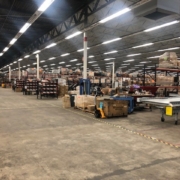A Day In the Life…Assembly, Machine Operation, Welding, Programming
What is it like to be in the field of assembly? Welding? Machine operation? ESI spoke to team members of some clients to find out.
Assembly
From a hiring perspective, assembly is broken down into two categories: light and industrial.
Rachel Garber-Biggs has been in the world of light assembly at Reacher Mfg. Corp. (RMC) for about a year. She is cross trained in all areas of manufacturing at RMC. Her days start at 5 or 6 a.m., depending on their work schedule. Assignments for work are distributed by leaders and she said you can expect to spend most of your day working in one area unless help is needed elsewhere. Everything you need for the assembly work is close, so you have quick access to parts and fasteners. Sometimes you may have to get more of something but most other times the parts are stocked for you. Some people chat throughout the day, while others work in silence, or while listening to their own music or podcasts. Rachel says the tools are basic, such as impact wrenches, or simple hand tools. She says keeping the facility clean is important and the last ten minutes of each day is used for cleaning and putting tools where they belong. Because of Rachel’s work ethic and positive attitude, she has gotten into other aspects of the business, like shipping.
Brandon Robinette has been at Quest Industrial Corp. (QIC) for over five years in industrial assembly. Although, like Rachel, he has gotten into other aspects of the business as well, like equipment inspections. Brandon says that assembly jobs are assigned by the leader and that they can take less than one day to complete, or in some cases, many weeks. It depends on the size and complexity of the job. Assemblers at QIC work with heavier parts and equipment than assemblers do at a place like RMC. They use more power tools, and the equipment they assemble often includes heavier components such as chains instead of rollers. Brandon enjoys the work because of the variety, and he enjoys helping others when he gets the chance.
Welding
Joe Rupert has been welding at Conveyor Systems, Inc. (CSI) for ten years. He enjoys the work, especially when equipment has a variety of welding to be done. Jobs vary in length it takes to complete them, depending on complexity and size. Sometimes they can get more than one job done in a day, and other times it may take several weeks to complete one job. Welders at CSI work in pairs which makes it easier to complete jobs because one person can work on each side of the equipment. If equipment takes more than one shift to build, the shifts team members will leave notes for one another to let them know where they are at on the project and anything else of importance. Jobs are mostly done with MIG welding, and with a variety of thicknesses of steel. When a job is done, they grab the next job in line, gather all parts for it, which are in various locations around the facility, both inside and out, and get to work welding.
Machine Operators and Programming
There are many different types of machines utilized by ESI clients. Although they each take different competencies to operate, the day to day surrounding working on the machines is similar. Steve Fenner has been working as a CNC Laser Operator at Metal Tech, Inc. (MTI) for eight months. He did work in industrial assembly at Wilco Mfg. Corp. (WMC) prior to that for four years. A CNC Laser machine cuts parts out of sheets of steel. The parts are programmed so that the least amount of waste is left from the sheet. Bill Hamel has been a Press Brake Operator at MTI for seven years. A Press Brake machine bends metal as needed and requires the operator to change dies according to the bends needed. The workday for their shift (first/day) starts at 5 a.m. for most, but for Bill, he comes in earlier, often at 3:30 a.m., to assist in getting jobs in order. There is not much downtime for either Steve or Bill as there is always something to do, whether it is programming the machine, changing dies, conducting maintenance on it, cleaning the area, or pulling parts/sheets for the next job. Both jobs require a certain amount of math and involve various thicknesses of metal.
For a CNC Laser Operator to do their job well, a programmer prepares the parts layout, or nesting, on the sheets of metal. Kyle Hanson has been in programming for 11 years at MTI, although he is currently transitioning into an operations role with Accumetal Solutions, LLC. The programmers use a computer program that assists by using algorithms to determine the best layouts for an efficient use of the metal with the goal being as little waste as possible. Programmers sometimes visit the shop floor to speak with the laser operators if something goes wrong or there are questions. Some sheets may have only two or three parts on it, while others may have thousands, depending on the sizes of the parts. Kyle has seen improvements in the software used for the process over the years. It used to be much more of a manual layout process, but now the technology makes it less manual and more efficient.

